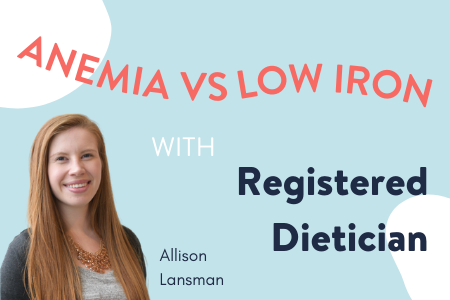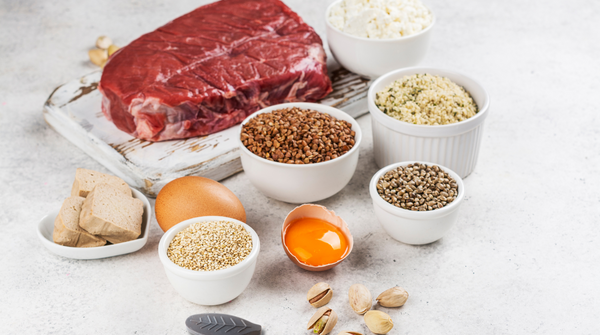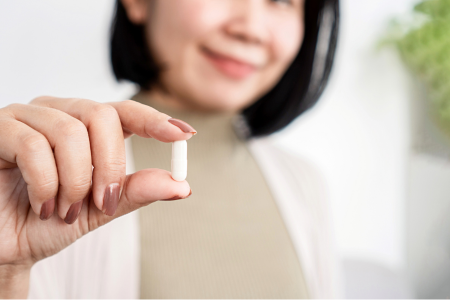Do You Have Low Iron Levels or Do You Have Anemia?

Author: Allison Lansman, RDN, LD
How’ve you been feeling lately?
Tired? Looking extra pale? Experiencing dizziness or headaches? Or maybe you notice your nails are brittle and breaking easily?
If you’re experiencing one or more of these symptoms, iron might be the cause.
Iron is an essential mineral that your body can only get from the food you eat. And if you aren’t eating enough iron-rich foods every day, you’re at risk of becoming iron deficient.
Most people who are iron deficient have no idea — when not managed in time, this can lead to a condition known as iron deficiency anemia. Anemia is actually a root cause of poor health for 30% of the world’s population!
But a big question remains for you— Do you just have low iron levels or do you have anemia?
Hopefully this informational article will help you understand iron, what it does in the body, and simple ways to improve your body’s iron levels.
What is Iron and Why is it Important
Iron is an essential mineral that your body cannot produce on its own. You must get it from the food you eat.
Iron needs vary depending on your age and sex. How much iron you need per day can be determined by a consultation with your physician. But current US National Institutes of Health recommendations for adults are:
- Age 19-50: 8mg (males), 18mg (females)
- Age 51+: 8mg (males and females)
In the body, iron plays a role in many vital biological processes. Including forming red blood cells (RBCs) as well as carrying oxygen and delivering it to the tissues, lungs, and brain. This mineral is a key component of hemoglobin in your RBCs. Iron’s the component in hemoglobin that binds to oxygen, carrying and delivering it where it's needed.
However, not eating enough iron every day can cause weak hemoglobin and reduce the number of RBCs in your blood. Both these things result in insufficient delivery of oxygen to the body, which end up causing extreme fatigue and various other negative health effects. As you can imagine, this can gravely impact your day-to-day life.
3 Reasons Your Iron Levels May Be Low
There are several reasons your iron levels could be low.
It’s estimated that nearly 80% of people around the world have low iron levels. Though it’s a common condition, it’s important to understand why YOU are deficient in iron.
Here are some frequent causes of low iron in the body:
- A LOW IRON DIET
A diet low in iron is the leading cause of iron deficiency.
Since your body cannot produce iron, your diet is the only way to get your daily iron needs. But if you aren’t eating enough iron-dense foods, your levels can drop quickly.
- POOR IRON ABSORPTION
Even if you're eating enough iron – if your body can’t absorb it, it doesn’t do you any good.
Poor iron absorption happens in the gut and can occur for many reasons.
One reason is a diet lacking in complementary vitamins that improve iron absorption. Vitamin C is well-known for assisting your body to absorb iron.
Absorption issues can also be caused by conditions of the digestive system that affect nutrient absorption. This includes gastrointestinal disorders or chronic kidney disease.
- BLOOD LOSS AND PREGNANCY
Blood loss or donation, due to trauma, disease, or monthly menstruation, is another cause, reducing the amount of the mineral in the body and oxygen carrying capacity.
Also, pregnancy can put a strain on your body’s iron levels since you’re sharing all of your vitamins and minerals with the baby.
So, What’s the Difference Between Iron Deficiency and Iron Deficiency Anemia?
Iron deficiency is having low blood iron levels for a short period and is linked to lifestyle and diet.
When left unmanaged for long periods of time, chronic low iron levels lead to the development of iron deficiency anemia.
Iron deficiency anemia is defined by weak hemoglobin structure and reduced RBCs found in your blood. This reduces the amount of oxygen being delivered throughout your body.
SYMPTOMS OF LOW IRON:
If low iron is an issue for you, you’re likely experiencing one or more these common symptoms:
- Fatigue
- Shortness of breath
- Weakness
- Lightheadedness
If so, begin by seeking care from your primary care physician. They will provide an official diagnosis on the severity of your deficiency, and prescribe a course of treatment that is right for you.
3 Simple Ways to Address Iron Deficiency and Iron Deficiency Anemia
Whether you are iron deficient or have iron deficiency anemia, there are several options to boost your iron levels.
- Eat a Healthy, Iron-Rich Diet
A healthy diet packed with iron-rich foods is the best habit for improving your iron.
Start by cutting back on highly processed and refined foods that are low in beneficial nutrients, like white bread or pasta and deli meats.
Instead, replace them with high-iron foods. Great sources of iron are:
- Lean proteins (red meats, chicken, lamb, and eggs)
- Seafood and shellfish
- Plant-based iron sources (beans, nuts, and tofu)
- Leafy green vegetables
- Fortified grains and cereals
These foods can boost your blood irons levels back up to normal. And improve your overall health.
- Eat foods that increase iron absorption
In addition to eating more iron-rich foods every day, you should also increase your intake of foods that improve iron absorption.
These foods contain vitamins that bind to iron and help it be absorbed in the gut. The most effective vitamins at enhancing the body’s ability to take in iron during digestion are vitamin C and vitamin A and beta-carotene.
Foods high in these vitamins, and can paired with iron-dense foods, include:
- Citrus fruits
- Peppers
- Melons
- Squash
- Carrots
- Sweet potatoes
There are also micronutrients and compounds that decrease iron absorption. They are still important for your health, but you’ll want to avoid pairing them together with iron-dense foods. These include phytic acid, polyphenols, and calcium.
- Supplement your diet with additional iron sources
Focusing on a healthy diet should be your first priority when increasing iron levels. But adding high-quality iron supplements, or adopting cooking tools like Lucky Iron Fish into your routine are also effective complimentary steps to improving your blood iron.
When adding iron sources to your diet, it may be beneficial to go with ones that releases iron that is easy to absorb and not cause side effects like stomach pains etc.
Address Your Low Iron Levels Today
By adopting simple steps into your routine, you can boost your iron levels, health, and energy. And, you’ll be able enjoy your day-to-day life without symptoms of iron deficiency or iron deficiency anemia getting in the way.




